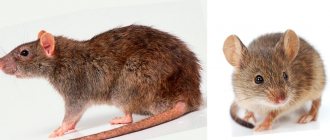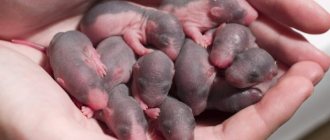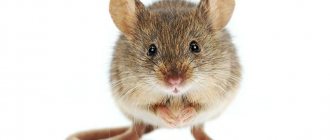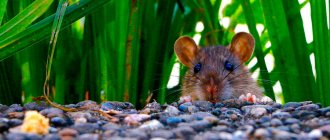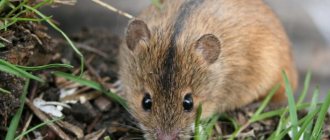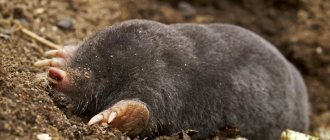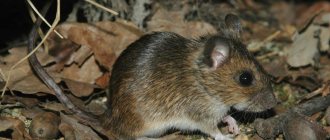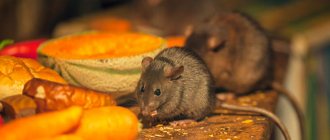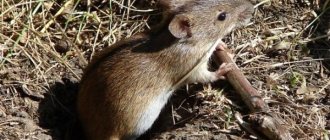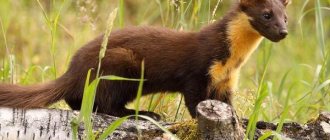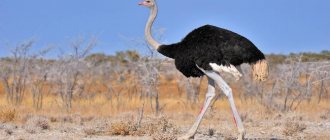Wood mouse – video
Externally, the wood mouse is very similar to the yellow-throated mouse, so the two species cannot always be clearly distinguished from each other. The wood mouse is considered one of the first species to inhabit deciduous and mixed forests, as well as strips of shrubs along arable lands.
This nocturnal rodent has excellent jumping and climbing abilities. Sounds in the ultrasonic range, which are inaudible to humans, are used when exploring an area, for personal hygiene, or for intraspecific communication. Because animals can navigate using the Earth's magnetic field, they have an excellent sense of direction and can always find their way back to burrow entrances.
Wood mice usually build their burrow underground. Aboveground nests can also be observed if the foliage is covered with a thick layer of leaf litter.
Reproduction occurs from March to September. The wood mouse is an omnivore, so it mainly feeds on seeds and avoids cellulose foods. The yellow-necked mouse acts as a competitor, which is the dominant species with high population densities.
On the other hand, bank voles avoid wood mice. Their predators are mainly birds of prey, owls, martens, foxes, cats and wild boars. Although the wood mouse makes a significant contribution to seed dispersal and forest restoration, today it is still erroneously considered a forest pest.
Field mouse in the house. Harvest mouse. Signs of appearance and methods of control
Reviewed by:
If you are the owner of a summer cottage, then it is unlikely that you could avoid meeting the vole mouse. The vole is a small rodent, the body length of which does not exceed 12 cm. The weight of this mouse reaches 30 grams. The rodent has a rather long tail, covered with scales with sparse hairs. The vole's skin has a reddish-brown tint, and the predominant color on the abdomen is white. As a rule, a dark stripe runs along the spine.
The main difference between the field mouse and the gray house mouse is the vole's more modest size, as well as its shorter tail and fur color.
The field mouse is very careful and swift; as soon as it senses danger, it quickly hides for cover. Moreover, this species is nocturnal - the animals rest during the day and are active at night.
This rodent lives almost everywhere, with the exception of the northern regions. At their summer cottage, mice choose places with tall grass. In summer, mice make nests in grass and bushes and raise their young. In winter, rodents move into houses where they can spend the winter in warmth.
Signs of a vole
Basically, the appearance of rodents can be detected by burrows and traces of their vital activity. Mice also leave marks of their teeth everywhere. Like most rodents, teeth
Voles grow throughout their lives, so mice have a constant need to chew on something. Voles can cause enormous damage to the garden, as they destroy the roots of shrubs and trees, and do not neglect flower bulbs. In just one day, an animal can eat as much different food as it weighs. Such gluttony is fraught with the death of trees and shrubs in the garden. In addition, voles love to stockpile food; for this purpose, their burrows are equipped with special “storage chambers.” Thus, one individual can eat up to 10 kg of food per season.
Another problem is the high fertility of rodents. In a year, a female can bear up to 4 litters, up to 8 pups at a time. Little mice reach sexual maturity by two months. The lifespan of a field mouse can reach up to 7 years, but in the wild, mice usually live for a year or two. Now imagine how quickly rodents can multiply in just one summer season, full of warmth and plenty of food.
In winter, voles do not hibernate, so in search of food they go to human habitation or gnaw the bark on the bottom of trees and shrubs.
As you already understand, field mice are not at all harmless and can cause great damage to the garden and crops. Therefore, it is worth starting the fight against mice as early as possible, as soon as you notice their appearance on your territory. Otherwise, you may face a real invasion of rodents, which will not be so easy to drive away.
How to get rid of a field mouse
To begin with, it is better to turn to more humane methods of struggle, simply to scare away and drive away uninvited guests. Mice have a good sense of smell, so there are smells that mice do not like. For these purposes, you can use plants such as:
- Garlic,
- Imperial hazel grouse,
- Blackroot,
- Elderberry ID.
To drive away rodents, just make an infusion of garlic or hazel grouse and pour it directly into the hole. For the same purposes, you can use thuja or elderberry twigs, garlic cloves and other plants that have a strong odor.
There are also chemicals that are unpleasant to voles. These include ammonia or kerosene. A cotton wool soaked in a chemical is placed in the hole, and the vole will leave its home forever.
Scientists have found that rodents are frightened by vibrations and shaking of the soil. This property can be used. To make a repeller, just dig wooden pegs next to the holes and hang cans on them. In windy weather, the jars will make sound and vibration, which will undoubtedly scare away the mice.
Manufacturers also offer ultrasonic repellers, which you can purchase in a specialized store. When choosing this device, it is worth considering where you will use it. If you need to drive away voles on your site, then you should choose a device that runs on batteries rather than on mains power. If voles have run into a barn or other room up to 200 m2, the budget “Tornado-200” is suitable for eliminating them. There is nothing superfluous in it - only a constantly jumping ultrasound frequency. It is these jumps that confuse the voles, forcing them to run away.
The above methods are absolutely safe for human health and your pets. But if you can’t cope with the voles, you should resort to “heavy artillery.”
Features of the biology of the wood mouse
Distinguishing a wood mouse from a yellow-throated mouse (Apodemus flavicollis) by external characteristics is difficult and completely impossible in young animals. Other identification possibilities are skull properties and fur hair imprints.
However, it should be noted that unambiguous identification of some animals in some habitats (especially when the alpine wood mouse Apodemus alpicola co-occurs) can only be correctly identified in adult animals using biochemical methods.
In general, in terms of external characteristics, the following differences can be found between the wood mouse and the yellow-throated mouse. This is only possible in the absence of the alpine wood mouse or their varieties. The wood mouse is usually smaller (hind leg length less than 22 mm), has less contrast and is lighter in appearance. Its underside is never pure white, but greyish. The separation of the colors of the top and bottom (back and abdomen) is less pronounced. The sebaceous gland pads (caudal organ) at the base of the tail are less noticeable.
Description
The body length of adult individuals is 8-13 cm, and the tail is 9-12 cm. Weight is 26-60 g. Large black eyes see well in the dark. Large ears are covered with short fur. At the tip of the muzzle there are long sensitive whiskers that provide orientation in space.
The color is reddish-brown or yellowish-brown. The abdomen is white. There is a yellow shirt-front located under the throat. The hind limbs are covered with white fur.
The front paws are useful for grasping and holding various objects. The hind limbs with elongated feet are adapted for moving by jumping. The back is brownish and the ventral part is white. The long thin tail is devoid of hair.
The incisors are constantly growing. The teeth are covered with durable, hard enamel. Females have 8 nipples.
In the wild, the yellow-throated forest mouse lives on average about 5 months. In captivity, she lives up to one and a half years.
Where does the wood mouse live?
The wood mouse, contrary to its name, lives not only in the forest. On the contrary, due to its adaptability it is considered a pioneer species.
It is one of the first to immigrate to areas of forest succession, where it can eventually reach high population densities.
This is mainly possible during long seasonal hikes. In the spring, the wood mouse migrates in strips of bushes to the fields, where it often remains until the end of the growing season.
In autumn it returns to the forest. In winter, the wood mouse often lives in human dwellings, and in the summer it leaves again.
In general, the wood mouse prefers habitats with open layers of grasses and shrubs, but can still be found in dense undergrowth or grain fields.
However, unlike the yellow-throated mouse, it avoids pure coniferous forests without undergrowth. It can often be found in deciduous and mixed forests (especially at the edges), on arable lands, in wetlands, in parks and gardens.
It typically colonizes closed areas of forest only when the dominant yellow-throated mouse is absent or occurs at low densities.
Natural value
The small wood mouse is a serious pest. It rarely affects agricultural crops, but causes significant damage to forests. In the case of a moderate population, this is not so noticeable, but if there are too many rodents, they can destroy almost the entire crop of tree seeds growing in the forest. They also interfere with the planting of new territories, since they eat the seeds even before they have time to germinate and bear fruit. In addition, they carry many infections and diseases, such as paratyphoid, tularemia and erysipelas.
Wood Mouse Activity
The activity of the wood mouse begins at dusk and leads a nocturnal lifestyle. In addition to increased activity during sunrise and sunset, phases of activity can also be observed throughout the day, depending on season, food availability, sex, and reproductive status.
Summer often sees only peak activity, with individual animals spending the entire night away from their nest. On average they are active 77% of the night. If this occurs at the same time as the bank vole (Myodes glareolus), the forest vole is more active at night, and the bank vole's behavior changes in turn to favor increased daytime activity.
Compared to other rodents of similar size, it has a high daily energy intake of 67.9 kJ per day. Pregnant females have a 24% increase in metabolism, which increases further while nursing their young and is 100% higher than normal.
Rodent lifestyle
Many rodents live in families or colonies, often very large ones. For example, the population of prairie dog colonies can reach 5 thousand individuals. A solitary lifestyle is more typical for species that can protect their food resources from competitors. Among them are inhabitants of dry steppes and deserts - hamsters and some desert mice.
Possessing acute senses, rodents communicate using hearing, vision and smell. Voice plays an important role in communication. For example, North American chipmunk squirrels and ground squirrels use a wide range of calls to alert neighbors to their presence and to defend territory. Their repertoire also includes special alarm signals used when a predator appears. In many other rodents, the frequency of sounds produced is beyond the range of human perception (about 45 kHz). In addition, they communicate through scent substances produced by various glands. Males usually have a stronger odor than females.
Nutrition
Most rodents eat a variety of plant foods, from leaves to fruits, sometimes supplementing their diet with small invertebrates such as spiders and grasshoppers. Some species (the field vole) feed on the bark of woody plants during periods of food shortage. Toxic substances contained in the bark are neutralized in the stomach of these animals by special enzymes, which allows the animals to survive lack of food.
Several species are specialist predators, such as the Australian water rat, which feeds on small fish, shellfish and frogs.
Reproduction
In most species, pregnancy lasts only 19-21 days, and the next mating occurs 2 days after birth. Cubs become sexually mature at 6 weeks of age.
Under suitable conditions, the number of rodents can increase to 1000-2000 per 1 hectare.
All stages of rodent reproduction - from attracting a sexual partner to mating and successfully raising young - are influenced by odor signals.
Rodents are under threat
The ability of rodents to quickly reproduce and colonize all kinds of habitats makes these mammals very important in many ecosystems. They also play an important role in human life.
But not all rodent species thrive. At least 50 species have gone extinct over the past two centuries, and more than 350 more may soon share their fate.
The 78 species most at risk are small, isolated populations that continue to decline. For some, such as the Margarita kangaroo and the Brazilian tree hamster, habitat protection offers hope for survival. For others, such as the reef mosaic rat, there is no hope - in 2016, a commission consisting of members of the Queensland Department of Environment and Heritage concluded that the animal became extinct due to frequent flooding on the flat sandy island where it lived.
About 100 species of rodents that are under threat of extermination are at somewhat lower risk. Their populations of up to 2,500 individuals are often divided into several endangered parts. For example, two species of Central American agouti and 6 species of Mexican forest hamsters fall into this category.
Literature: Mammals: Complete illustrated encyclopedia /Translated from English/ Book. II. Half-ungulates, ungulates, rodents, lagomorphs, elephant jumpers, insectivores, chiropterans, edentates, marsupials, monotremes. / Ed. D. MacDonald. – M: “Omega”, – 2007.
What does a wood mouse eat?
The wood mouse feeds on seeds of trees and grasses, shoots and stems, roots, berries and fruits. The fruiting bodies of mosses are particularly popular and consumed for their high lipid content.
Berries are an important food source for wood mice, especially in autumn, and acorns and beech nuts in winter. The share of animal food is highest in spring and summer – 20%. It feeds on a variety of insects (including Colorado potato beetles), snails and earthworms, and may also feed on bird eggs, young chicks and small bats.
Essentially, the wood mouse eats the same way as the yellow-throated mouse.
domestic exhaust fans price
DID YOU KNOW?
- If you grab a mouse by the tail, the skin covering it bursts, and the animal runs away, leaving only a pitiful piece of epidermis as a souvenir for the enemy. The skinless fragment of the tail soon dries out and falls off, and the mouse walks around with a stubby tail for the rest of its life.
- Forest mice can rightfully be called diligent assistants to foresters. Dragging acorns, nuts and seeds into the hole, they inevitably lose along the way some of the reserves from which young shoots sprout in the spring.
- The wood mouse belongs to the order of rodents. The Latin name of this order, Rodentia, comes from the verb “rodere” - “to gnaw”. A distinctive feature of this group of animals is their perfectly developed jaws, each of which is armed with a pair of sharp incisors. When crushing solid food, the incisors wear out, but continue to grow throughout life.
- Rodents make up about one third of all land mammals. The massive distribution of these animals is due to their incredible fertility and ability to adapt to a wide variety of, sometimes extreme, living conditions.
Wood mouse population
The wood mouse population depends on breeding, which occurs from March to September. After a gestation period of 23 to 26 days, 5 to 6 young animals are born. The female is ready to be reintroduced immediately after giving birth (postpartum estrus).
After a period of feeding on mother's milk of about 3 weeks, the offspring accompany their mother for some time in search of food before becoming independent. Males reach sexual maturity in the third month of life.
While winter breeding can only be observed periodically in Central Europe. Wood mice mate in coastal areas mainly at this time of year but, on the other hand, take a break during the dry and hot summer months.
Animals born in the spring usually do not survive the following winter, and those born later form the core of the wood mouse population for the following year. Due to its short lifespan of only 12 months, the female gives birth to offspring on average 2-3 times during her life.
High, unclear fluctuations in population density are often observed. This can usually be justified by the migratory behavior of the species and is mainly based on food availability. For example, the density in forest habitats increases significantly after the grain harvest and reaches 50-100 individuals per hectare. As a rule, in spring this number is less - 5 individuals per hectare, in autumn - 20-40.
In general, populations in mixed forests often range from 1 to 40 individuals per hectare, and in structurally rich arable lands from 1 to 30.
Reproduction and offspring
Immediately after waking up from hibernation, animals go in search of a family partner. Males, driven by instinct, wake up earlier. They are very active during this period, endlessly rushing along the branches, marking everything in their path. Females wake up a little later. They begin to make special attracting sounds, then look for the males’ marks so that they can leave their own in their place.
The female's pregnancy lasts about 28 days. During this period, they show all the signs of a typical mother expecting an addition. Females repair and tidy their nest, improve it, throwing out and replacing damaged parts. The day before the babies are born, they kick out the males who have fulfilled their purpose. Dormouse couples are temporary; there is no talk of long-term and faithful “love.”
Most often there is only one brood per year. In rare cases, in warm climates there may be 2 of them. Up to 8 babies are born in one litter. After birth, mothers constantly comb and lick their naked, pink and completely helpless children. Only by the 16th day of life does the first fluff appear on their body and their eyes open.
The female leaves the nest only to feed. Babies sometimes fall outside the home, but mothers unmistakably identify them by their characteristic squeak and drag them back to their father’s house.
At the age of one and a half months, babies can live independently, but many never leave the nest. Provided there is enough food, dormice can remain in groups.
Wood mouse interesting facts
DID YOU KNOW THAT...
In winter, by reducing their metabolism, the wood mouse can survive cold days and hunger. With such torpor, body temperature may drop to its lowest point.
The rodent is able to navigate by the earth's magnetic field.
The wood mouse is extremely voracious - it eats up to 20 times a day.
The animal is clean and neat.
Communication and exploration of the area occurs in the ultrasonic range, which is inaudible to humans.
Description of the wood mouse
The fur on the back and sides is light brown to gray-brown.
Old animals are medium brown with a red-brown tint. The center of the back is darker. The underside is grey-white, never pure white. The chest is often with a variable yellow buffy patch that may extend in a line to the belly (usually 3 times the width), the patch is never in the form of a continuous stripe. The rodent has large eyes and ears.
The tail is two-colored, with a light underside, shorter than the body length. The skin of the tail is easily torn off, a type of tail autotomy.
Wood mouse dimensions
Length of the body and head: 102 and 68 mm, respectively;
Hind paw size: 20 to 22.7 mm;
Hibernation
Hibernation is an important and responsible period in the life of a dormouse. Animals begin to prepare for it from the end of summer, intensively accumulating fat. If in summer the average forest dormouse weighs about 30 grams, then by the beginning of hibernation it is already 60-70 grams.
This species of dormouse has the weakest winter sleep: if disturbed by people or animals, they may no longer fall asleep at all, which, in the absence of food, will inevitably lead to death.
A sleeping dormouse curls up into a ball, cold and hard to the touch (after all, her body temperature at this time is only 1°C higher than the air temperature!).
The weight of a sleeping animal decreases daily, and by spring the dormouse weighs half as much as in the fall. Having woken up, thin and hungry animals, even in captivity, eat about one and a half times more per day than in summer.
Where do wood mice live?
Wood mice live and are widespread in Europe and North Africa. In Austria it is found in all federal states. In Germany the population is lower than that of the yellow-necked mouse (Apodemus flavicollis). In Switzerland there is a lot of it throughout the country.
Their altitude distribution extends up to 1900 m.
Danger to the wood mouse
The wood mouse is not a forest pest because it does not harm plants. On the contrary, it significantly contributes to the dissemination of seeds of certain plant species: strawberries, blueberries and lingonberries. The seeds of these plants are able to germinate even after digestion.
Mouse storage chambers also have a positive effect on forest restoration. And, as in the case of the yellow-throated mouse, it can be assumed that the seeds with spines and bristles are caught in their fur and thus distributed over a radius of up to 30 m.
Therefore, the fight against the wood mouse is neither reasonable, nor necessary, nor justified. These rodents are considered extremely adaptive. However, there is still a danger to the wood mouse. To thrive, they require at least sufficient food, a warm microclimate, and heterogeneous structural diversity with both open and dense areas of vegetation.
Pet house
Despite its small size, a bat at home needs a very spacious enclosure where the pet will be able to fly. It is necessary to equip the house with branches and shelters so that the animal has the opportunity to hide during the daytime rest.
The vital functions of bats directly depend on the ambient temperature, so the room where the pet lives should be approximately 30 degrees, which is quite high for a comfortable stay for a person.
A bird cage is not always suitable for keeping bats, since the distance between the twigs is sufficient so that one fine night you can find that the animal is flying above your heads and happily feasting on insects.
Wood mouse hole
The wood mouse burrow can be above ground or underground. Surface nests are usually only observed when there is a high layer of foliage or when the soil is moist. She places them, along with storage lockers, in cavities made of rotten wood or builds them on top of existing bird nests.
Digging a hole is mainly done with the help of the lower incisors. The front paws are used almost exclusively for removing accumulated soil. She is pushed under the stomach and then thrown away with her hind legs.
The size, depth and shape of earthworks depend on the nature of the soil, water balance, ground cover, topography and the presence of other habitat structures. As a rule, they are not deep (up to 50 cm), about 2.5 meters long and consist of 1 chamber with 2-6 well-hidden entrances.
The space, only about 15 cm in size, is used for storing supplies and is lined with leaves and moss. The bend in the corridor serves as a vestibule, and the vertical corridor (drainpipe) serves for ventilation.
Especially during the cold winter months, the wood mouse's burrow is insulated with leaves, moss and grass. When raising the young, the female closes the entrances with soil and plant material upon exiting.
The expansion of the building and the amount of material introduced varies depending on the outside temperature. Presumably, nests are shared with relatives only in winter, and in summer, at least, females build separate burrows for themselves
Control measures: deratization measures
Sanitary and epidemiological well-being is due to the successful implementation of the entire complex of deratization measures, including organizational, preventive, exterminatory and sanitary educational measures to combat rodents.
Organizational measures include a set of the following measures:
- administrative;
- financial and economic;
- scientific and methodological;
- material.
Preventive measures are designed to eliminate favorable living conditions for rodents and exterminate them using the following measures:
- engineering and technical, including the use of various devices that automatically prevent rodents from accessing premises and communications;
- sanitary and hygienic, including maintaining cleanliness in the premises, basements, and areas of the facilities;
- agro- and forestry engineering, including measures for the cultivation of forests in recreational areas to the state of forest parks and maintaining these areas in a state free from weeds, fallen leaves, dead and drying trees; This same group of activities includes deep plowing of the soil in the fields;
- preventive deratization, including measures to prevent the restoration of the number of rodents using chemical and mechanical means.
The task of carrying out this group of activities lies with legal entities and individual entrepreneurs operating specific facilities and the surrounding territory.
Extermination activities are carried out in populated areas, on agricultural lands, as well as various foci of infectious diseases in order to completely clear objects of rodents and are reduced to the following methods of deratization:
- physical, involving the use of mechanical devices, ultrasonic emitters, glue traps, electrical barriers to destroy rodents;
- chemical, during which rodenticides, rodenticides with synergists in various forms and repellents are used;
- biological, including the use of pathogenic microflora, parasites and predatory animals to destroy rodents.
These events are carried out by legal entities and individual entrepreneurs with special training.
How do they tolerate frost?
The mouse, like most rodents, cannot boast of large body sizes, so it is difficult for it to maintain a normal temperature.
To regulate this indicator, they try to generate more internal heat. The stronger the frost, the more heat the body produces.
If a rodent's vital activity decreases, this can lead to death . If the body is cooled for a long time, then nutrients begin to be rapidly consumed.
And those supplies that fill winter pantries are usually not able to make up for the resulting shortage.
Pet diet
So what to feed mice, so to speak, in captivity, but fully and with benefit for their body? The so-called menu, close to the natural diet, for the described pets should consist of the following products:
- Cereals – grains of wheat, oats and barley;
- Seeds – 2 or 3 kernels per day (no more);
- Protein-rich ingredients in the form of boiled or raw quail eggs, boiled chicken meat, boiled shrimp (once every 7 days), dried, freshwater crustaceans sold in pet stores;
- Vegetables, especially carrots;
- Fruits that can be used as treats, as well as berries in the form of currants, wild strawberries, strawberries;
- Nuts in the form of hazelnuts, walnuts, peanuts (but not more than 1 kernel per day);
- Greens (small portions) in the form of parsley, lettuce, cilantro;
- Cheese. Although this ingredient is a favorite delicacy of mice, it is necessary to give it to rodents as rarely as possible, since this product can easily provoke obesity;
- Bread, preferably black (it is recommended not to give often);
- Clean and fresh water, in the required quantity (at least 30 grams per day).
Branches from trees are recommended for grinding teeth of mice. Suitable for these purposes are rowan, apple, hazel or willow. Coniferous trees will saturate the body of mice with vitamin C.
